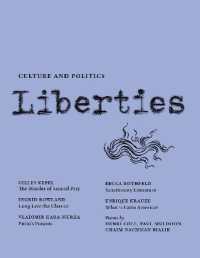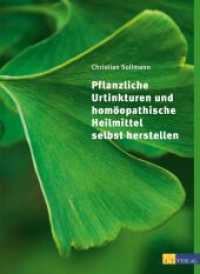- ホーム
- > 洋書
- > 英文書
- > Nature / Ecology
Full Description
This collection features five peer-reviewed literature reviews on mycotoxin control in agriculture.
The first chapter reviews advances in post-harvest detection and control of fungal contaminants in cereals. It examines abiotic factors affecting spoilage, methods for early detection of contamination and the range control measures for preventing toxin growth.
The second chapter focuses on post-harvest storage and handling practices of barley grain and how these methods can be used to mitigate mycotoxin issues. The chapter also reviews the various mycotoxins and fungi that are associated with barley.
The third chapter considers the current strategies available to prevent mycotoxin contamination in groundnut cultivation, focussing on peanuts. It also covers models that predict contamination, as well as the challenges associated with research and quantification of aflatoxin.
The fourth chapter presents an overview of the current understanding of mycotoxin contamination of cocoa. The chapter summarises the various methods available to aid detection of mycotoxins and control further contamination.
The final chapter addresses the critical safety issue of mycotoxin contamination of food waste planned for re-use. It reviews factors affecting mycotoxin growth and the particular problem of masked mycotoxins.
Contents
Chapter 1 - Advances in post-harvest detection and control of fungal contamination of cereals: Naresh Magan, Esther Garcia-Cela, Carol Verheecke-Vaessen and Angel Medina, Cranfield University, UK; 1 Introduction 2 Factors affecting the activity of spoilage moulds and mycotoxin contamination 3 Volatiles as an early indicator of spoilage of stored cereals 4 Carbon dioxide monitoring for real-time identification of the risk of spoilage moulds and mycotoxins in stored cereals 5 Control strategies to minimise spoilage and mycotoxin contamination of stored grain: monitoring of relative humidity (RH) and temperature and the use of molecular methods 6 Control strategies: hermetic storage of grain and use of natural compounds 7 Control strategies: biological control and irradiation techniques 8 Control technologies: cold plasma technology and ozone fumigation 9 Conclusions 10 Where to look for further information 11 References
Chapter taken from: Maier, D. (ed.), Advances in postharvest management of cereals and grains, Burleigh Dodds Science Publishing, Cambridge, UK, 2020, (ISBN 978 1 78676 352 5)
Chapter 2 - Advances in postharvest storage and handling of barley: methods to prevent or reduce mycotoxin contamination: Zhao Jin and Paul Schwarz, North Dakota State University, USA; 1 Introduction 2 Postharvest handling and storage operations for barley 3 Mycoflora and mycotoxins of barley 4 Prevention or decontamination of mycotoxins in barley storage 5 Post-storage treatment of barley 6 Conclusion and future trends 7 Where to look for further information 8 References
Chapter taken from: Fox, G. and Li, C. (eds.), Achieving sustainable cultivation of barley, Burleigh Dodds Science Publishing, Cambridge, UK, 2020, (ISBN 978 1 78676 308 2)
Chapter 3 - Preventing mycotoxin contamination in groundnut cultivation: David Jordan, Rick Brandenburg and Gary Payne, North Carolina State University, USA; David Hoisington, Nick Magnan and James Rhoads, The University of Georgia, USA; Mumuni Abudulai, Savanna Agricultural Research Institute, Ghana; Koushik Adhikari and Jinru Chen, The University of Georgia, USA; Richard Akromah, William Appaw and William Ellis, Kwame Nkrumah University of Science and Technology, Ghana; Maria Balota and Kumar Mallikarjunan, Virginia Polytechnic Institute and State University, USA; Kenneth Boote and Greg MacDonald, University of Florida, USA; Kira Bowen, Auburn University, USA; Boris Bravo-Ureta and Jeremy Jelliffe, University of Connecticut, USA; Agnes Budu, University of Ghana, Ghana; Hendrix Chalwe, Alice Mweetwa and Munsanda Ngulube, University of Zambia, Zambia; Awere Dankyi and Brandford Mochia, Crops Research Institute, Ghana; Vivian Hoffmann, International Food Policy Research Institute, USA; Amade Muitia, Mozambique Institute of Agricultural Research, Mozambique; Agnes Mwangwela, Lilongwe University of Agriculture and Natural Resources, Malawi; Sam Njoroge, International Crops Research Institute for the Semi-Arid Tropics (ICRISAT), Malawi; David Okello, National Semi-Arid Resources Research Institute (NaSARRI), Uganda; and Nelson Opoku, University for Development Studies, Ghana; 1 Introduction 2 Factors impacting aflatoxin development 3 Prediction models for aflatoxin development 4 Minimizing aflatoxin contamination 5 Aflatoxin contamination during drying, storage and processing 6 Challenges in mycotoxin research 7 Value chain projects 8 Conclusion 9 Where to look for further information 10 References
Chapter taken from: Sivasankar, S., Bergvinson, D., Gaur, P., Kumar, S., Beebe, S. and Tamò, M. (eds.), Achieving sustainable cultivation of grain legumes - Volume 2: Improving cultivation of particular grain legumes, Burleigh Dodds Science Publishing, Cambridge, UK, 2018, (ISBN 978 1 78676 140 8)
Chapter 4 - Mycotoxins in cocoa: causes, detection and control: Mary A. Egbuta, Southern Cross University, Australia; 1 Introduction 2 Mycotoxins contaminating cocoa 3 Detection of mycotoxins in cocoa 4 Controlling mycotoxins in cocoa production 5 Conclusion 6 Where to look for further information 7 References
Chapter taken from: Umaharan, P. (ed.), Achieving sustainable cultivation of cocoa, Burleigh Dodds Science Publishing, Cambridge, UK, 2018, (ISBN 978 1 78676 168 2)
Chapter 5 - Reusing food waste: the importance of mycotoxin detection and decontamination: F. Ascencio, Centro de Investigaciones Biológicas del Noroeste, Mexico; and T. Sandoval-Contreras, Instituto Tecnológico de Tepic, Mexico; 1 Introduction 2 Recycling and reuse of food waste 3 Mycotoxins, food production and food waste 4 Factors affecting mycotoxin growth 5 The problem of masked mycotoxins 6 Detection and modeling of mycotoxin contamination 7 Processing methods to inactivate mycotoxins 8 Biological degradation of mycotoxins and mycotoxin-adsorbing agents 9 Where to look for further information 10 References
Chapter taken from: Yahia, E. (ed.), Preventing food losses and waste to achieve food security and sustainability, Burleigh Dodds Science Publishing, Cambridge, UK, 2020, (ISBN 978 1 78676 300 6)







